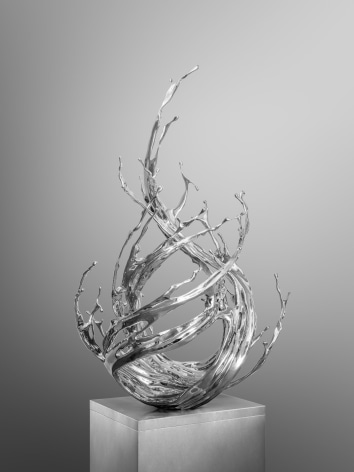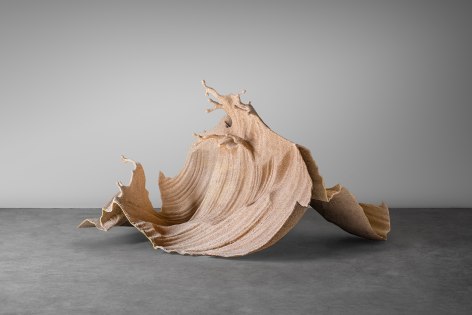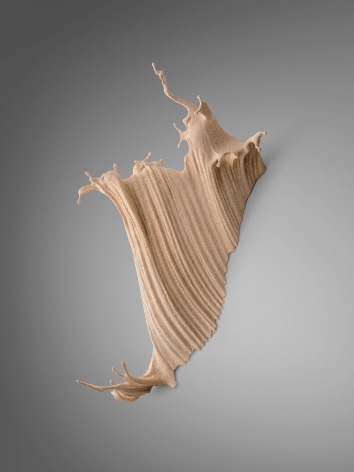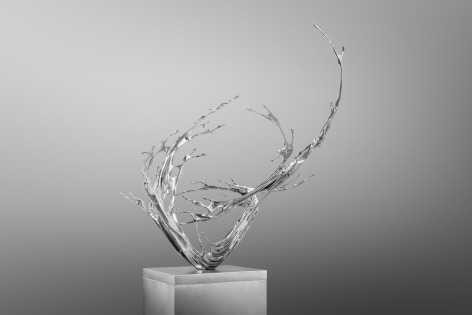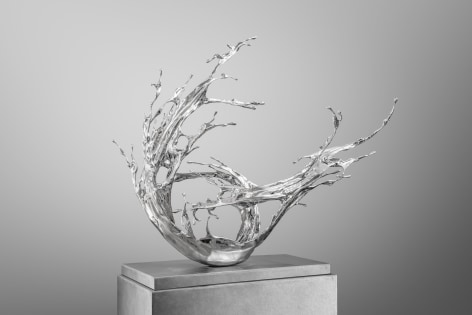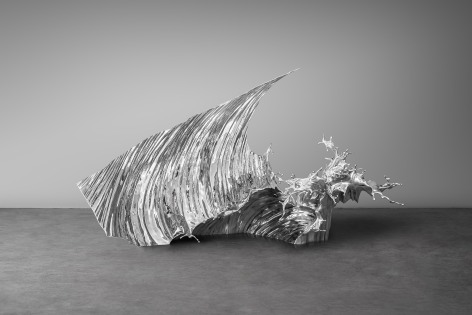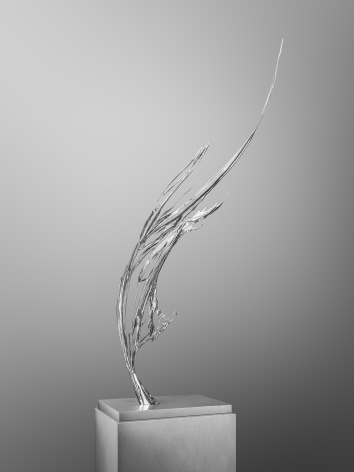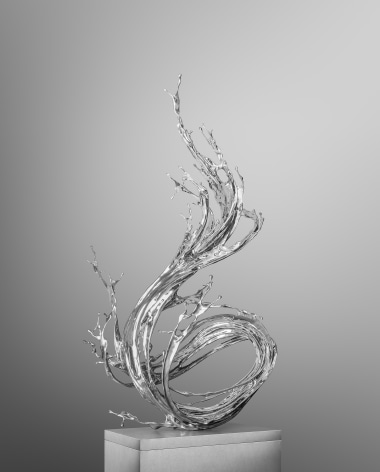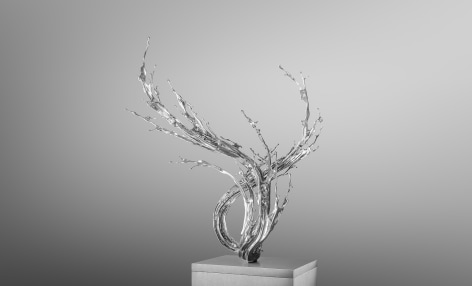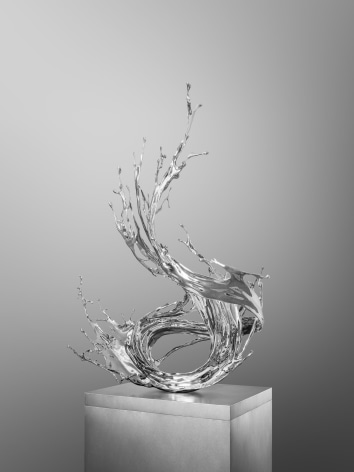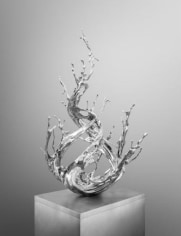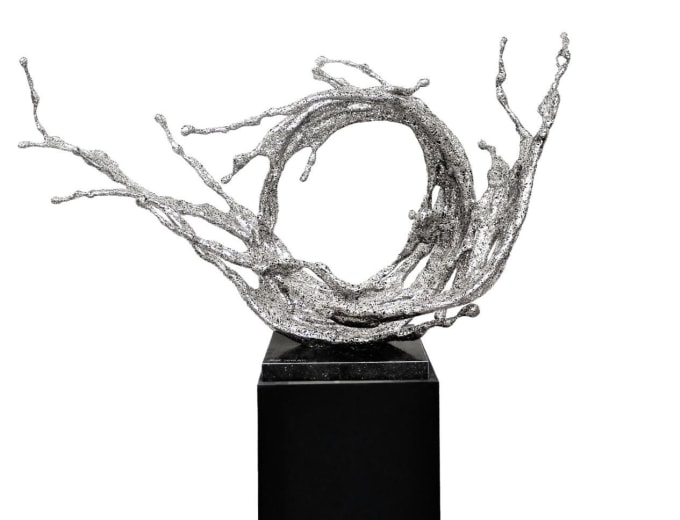
We are pleased to present a sculpture exhibition by Beijing-based artist Zheng Lu (b. 1978, Chifeng, Inner Mongolia). The show features a new body of work, Tide Crossing, inspired by the poetry of Rabindranath Tagore alongside recent sculptures from the artist’s celebrated Water in Dripping series, which has garnered international attention.
Zheng is known for his technically ambitious sculptures, often focusing on water, which have been exhibited in museums and public spaces around the world, including a massive cascading work at Hengdian World Studios, known as Chinawood, in Hangzhou, China; a twenty-three-foot-tall steel sculpture installed in a residential complex on Jersey in the Channel Islands; and a twenty-foot-tall stainless-steel sculpture exhibited in Dag Hammarskjöld Plaza adjacent to the United Nations in New York, now in a private collection in the United States.
Zheng comes from a literary family and often draws from poetry and traditional Chinese philosophy as a conceptual foundation for his work. This exhibition takes its title from a line in Stray Birds, a collection of poems by Rabindranath Tagore (1861–1941), the first Asian Nobel laureate whose poetry, fiction, music and art have touched the lives of people all over the world, particularly in China, where his historic visit in 1924 marked a significant milestone in China-India relations.
The poem, which alludes to the fleeting nature of existence, inspired Zheng’s most recent work, Tide Crossing. In this series, the sculptures take the fluid, rippling form of moving water but their tactile, sand-like surfaces are more suggestive of a dry riverbed. The striking imagery brings the past, present and future together and as the artist describes it, “prompts us to contemplate the value of life and reminds us to cherish the present and actively face the future. At the same time, it also makes us respect nature more and coexist harmoniously with it.”
Zheng’s reverence for nature is a recurring theme throughout his practice, particularly in his Water in Dripping sculptures. Pulsing with movement, the dynamic stainless-steel compositions evoke splashes of water suspended midair. In some works, Zheng uses language as a pictorial element, composing the surface of the sculptures out of thousands of Chinese characters derived from texts of historical significance.
Over the years, the series’ compositions have become more distilled, with smooth, burnished surfaces that amplify the dichotomy between stillness and movement. Sunburst, 2025, for example, almost entirely shifts away from referencing water directly, but shares the same fluid form and stylized movement characteristic of the series. Earlier works are fabricated from cast pieces welded together, but Sunburst is formed from solid ribbons of steel, with one side highly polished and the other side matte.
Sternstunde, 2025, also expands the series, conveying the power of moving water in the form of a cresting wave. The sculpture’s gleaming metallic surface captures the light and reflects the surrounding environment, which heightens the sense of motion as the viewer moves around the work.
Presented together, the sculptures in this exhibition demonstrate Zheng’s defining desire to venture into new territory, both conceptually and technically. In each series, he skillfully merges concepts rooted in Chinese philosophy and elements of the natural world with material explorations that push the boundaries of physical form. With his unique visual language, Zheng Lu transforms water into poetic expressions that reveal deeper truths about relationships between humanity and the natural world.
Zheng Lu graduated from Lu Xun Fine Art Academy, Shenyang, with a bachelor of fine arts degree in sculpture in 2003. In 2007, he completed a master of fine arts degree in sculpture from the Central Academy of Fine Art, Beijing, while also attending an advanced study program at the École Nationale Supérieure des Beaux-arts in Paris.
The artist has participated in numerous museum exhibitions in China and abroad, including at the National Museum of China, Beijing; Long Museum, Shanghai, and Shanghai Duolun Museum of Modern Art; Museum on the Seam, Jerusalem; Musée Océanographique, Monaco; and Musée Maillol, Paris. In 2015, the artist’s work was featured in a solo exhibition at the Museum of Contemporary Art Taipei, one of the leading institutions in the region. In 2023, his work was featured at Asia Society Texas in Houston in Summoning Memories: Art Beyond Chinese Tradition.

